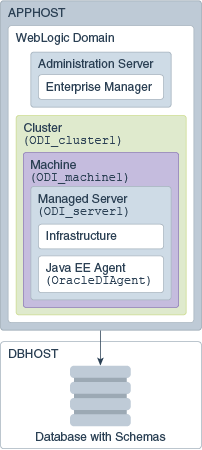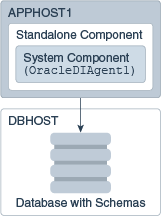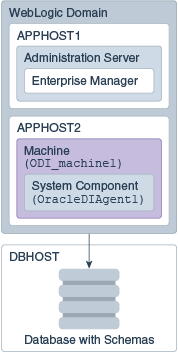1 Planning the Oracle Data Integrator Installation
Understand the information in this chapter thoroughly to minimize issues during product installation and configuration.
This chapter includes the following sections:
- About Oracle Data Integrator Installation
Learn about installing Oracle Data Integrator in the standard topology, when upgrading a domain, or when extending a domain. - Understanding Oracle Data Integrator Run-Time Agents
An Oracle Data Integrator agent can be one of three different kinds: Java EE, standalone, or standalone collocated. - Using Oracle Data Integrator Studio
Oracle Data Integrator Studio (ODI Studio) is a developer's interface for configuring and managing Oracle Data Integrator (ODI) - Understanding Oracle Data Integrator Topology
An Oracle Data Integrator topology is the physical and logical representation of the Oracle Data Integrator architecture and components. - Understanding the Oracle Data Integrator Standard Installation Topologies
Learn how to install and configure a standard installation topology for Oracle Data Integrator. - Installing and Configuring the Standard Installation Topology
Install and configure the standard Oracle Data Integrator topology. - Obtaining the Necessary Product Distributions
Learn about the pre-requisites to create a Java EE or standalone collocated agent.
1.1 About Oracle Data Integrator Installation
Learn about installing Oracle Data Integrator in the standard topology, when upgrading a domain, or when extending a domain.
This topic the following topics:
- Using the Standard Installation Topology as a Starting Point
Use the standard installation topology when installing Oracle Data Integrator. Other starting point topologies are available. - Using this Document in an Upgrade Scenario
Install Oracle Data Integrator when you are updating the product. - Using this Document to Create a Domain
Learn how to create a domain when no other Oracle Fusion Middleware product is installed on your system.
1.1.1 Using the Standard Installation Topology as a Starting Point
Use the standard installation topology when installing Oracle Data Integrator. Other starting point topologies are available.
This guide helps you create the standard installation topologies for Oracle Data Integrator (Understanding the Oracle Data Integrator Standard Installation Topologies). The Java EE Agent topology (Understanding the Standard Installation Topology for the Java EE Agent) can be extended to be highly available and secure, making it suitable for a production system.
A standard installation topology represents a sample topology for this product; it is not the only topology that is supported. For more information, see Understanding the Standard Installation Topology.
1.1.2 Using this Document in an Upgrade Scenario
Install Oracle Data Integrator when you are updating the product.
If you are installing Oracle Data Integrator as part of an upgrade procedure, follow the instructions in this book to install the software, but do not run the Configuration Wizard to create a WebLogic domain.
After the software is installed, refer to Upgrading Oracle Data Integrator.
1.1.3 Using this Document to Create a Domain
Learn how to create a domain when no other Oracle Fusion Middleware product is installed on your system.
It is assumed that no other Oracle Fusion Middleware product is installed on your system. All of the instructions for installation and domain creation are based on this assumption.
In the event that you already have other Oracle Fusion Middleware products installed on your system (for example, you are creating the Java EE agent topology and you already have Oracle Fusion Middleware Infrastructure installed with a domain that is up and running), the same instructions can be used to extend your existing domain. For details, see "Installing Multiple Products in the Same Domain" in Planning an Installation of Oracle Fusion Middleware.
If you are creating a new domain but your needs do not match the instructions given in the procedure, be sure to make your selections accordingly and refer to the supporting documentation for additional details.
1.2 Understanding Oracle Data Integrator Run-Time Agents
An Oracle Data Integrator agent can be one of three different kinds: Java EE, standalone, or standalone collocated.
Oracle Data Integrator includes the following three types of agents:
-
Java EE
-
Standalone
-
Standalone collocated
For information about these run-time agent types, see Run-Time Agent.
1.3 Using Oracle Data Integrator Studio
Oracle Data Integrator Studio (ODI Studio) is a developer's interface for configuring and managing Oracle Data Integrator (ODI)
To learn how to use ODI Studio to configure and manage your ODI topology, see Configuring Oracle Data Integrator Studio.
1.4 Understanding Oracle Data Integrator Topology
An Oracle Data Integrator topology is the physical and logical representation of the Oracle Data Integrator architecture and components.
Before you can begin developing using Oracle Data Integrator, you must first set up an Oracle Data Integrator topology, which is the physical and logical representation of the Oracle Data Integrator architecture and components. The Oracle Data Integrator topology defines where to find the sources and targets of the data that you are integrating.
Note that this topology is not the same as the standard installation topology, which is the layout of files installed and configured on your computer by the Oracle Universal Installer and the configuration wizard.
More information about the Oracle Data Integrator topology can be found in Setting up a Topology.
1.5 Understanding the Oracle Data Integrator Standard Installation Topologies
Learn how to install and configure a standard installation topology for Oracle Data Integrator.
You can install and configure any of the following Oracle Data Integrator standard installation topologies:
-
Standard installation topology for the Java EE agent.
The Java EE agent is installed into an existing Oracle home containing Oracle Fusion Middleware Infrastructure. Along with the Java EE agent, ODI Console, ODI Studio, and the plugin for Fusion Middleware Control are also installed in the topology. See Understanding the Standard Installation Topology for the Java EE Agent.
-
Standard installation topology for the standalone agent.
The standalone agent is installed and configured in a standalone domain. See Understanding the Standard Installation Topology for the Standalone Agent.
-
Standard installation topology for the standalone colocated agent.
The standalone agent is installed and configured with a WebLogic domain and managed using the Node Manager and Administration Server. SeeUnderstanding the Standard Installation Topology for the Standalone Collocated Agent.
For procedure details, see Installing and Configuring the Standard Installation Topology.
This topic incudes the following tasks:
- Understanding the Standard Installation Topology for the Java EE Agent
Learn about the standard installation topology for Oracle Data Integrator Java EE agent. - Understanding the Standard Installation Topology for the Standalone Agent
Learn about the standard installation topology for the standalone agent. - Understanding the Standard Installation Topology for the Standalone Collocated Agent
Learn about the standard installation topology for the standalone collocated agent.
1.5.1 Understanding the Standard Installation Topology for the Java EE Agent
Learn about the standard installation topology for Oracle Data Integrator Java EE agent.
Figure 1-1 shows the standard installation topology for Oracle Data Integrator Java EE agent.
Figure 1-1 Standard Installation Topology for the Java EE Agent

This topology represents a standard WebLogic Server domain that contains an Administration Server and a Managed Server on which the Infrastructure and Java EE agent are deployed. The Managed Server is targeted to a machine inside a cluster. The domain is configured on a single host and requires a supported database where the required Fusion Middleware schemas are installed.
Note:
'The infrastructure can use more than one machine for scalability and high-availability considerations. See Preparing Your Environment For High Availability for more information.
All elements in this standard installation topology illustration are described in Table 1-1.
Table 1-1 Description of the Elements in the Java EE Standard Installation Topology
| Element | Description and Links to Additional Documentation |
|---|---|
|
APPHOST |
Standard term used in Oracle documentation referring to the computer that is hosting the application tier. |
|
DBHOST |
Standard term used in Oracle documentation referring to the computer that is hosting the database. |
|
WebLogic Domain |
A logically related group of Java components (in this case, the administration Server, Managed Servers, and other related software components). For more information, see What is an Oracle WebLogic Server Domain. |
|
Administration Server |
The central control entity of a domain which maintains the domain's configuration objects and distributes configuration changes to Managed Servers. For more information, see "What is the Administration Server" in Understanding Oracle Fusion Middleware. |
|
Enterprise Manager |
Oracle Enterprise Manager Fusion Middleware Control. For more information, see "Oracle Enterprise Manager Fusion Middleware Control" in Understanding Oracle Fusion Middleware. |
|
Cluster |
A collection of multiple WebLogic Server instances running simultaneously and working together. For more information, see Understanding Managed Servers and Managed Server Clusters. |
|
Machine |
Logical representation of the computer that hosts one or more WebLogic Server instances (servers). Machines are also the logical glue between WebLogic Managed Servers and the Node Manager; in order to start or stop a Managed Server with Node Manager, the Managed Server must be associated with a machine. |
|
Managed Server |
Host for your applications, application components, Web services, and their associated resources. For more information, see Understanding Managed Servers and Managed Server Clusters. |
|
Infrastructure |
Collection of services that include the following:
|
|
Java EE Agent |
The Java EE agent. For more information about Java EE agents, see Run-Time Agent. |
1.5.2 Understanding the Standard Installation Topology for the Standalone Agent
Learn about the standard installation topology for the standalone agent.
Figure 1-2 shows the standard installation topology for the standalone agent.
Figure 1-2 Standard Installation Topology for the Standalone Agent

This topology represents a standalone agent configured in a standalone domain, managed by the WebLogic Management Framework. The domain is configured on a single host and requires a supported database where the required Fusion Middleware schemas are installed.
All elements in this standard installation topology illustration are described in Table 1-2.
Table 1-2 Description of the Elements in the Standalone Agent Standard Installation Topology
| Element | Description and Links to Additional Documentation |
|---|---|
|
APPHOST |
Standard term used in Oracle documentation referring to the computer that is hosting the application tier. |
|
DBHOST |
Standard term used in Oracle documentation referring to the computer that is hosting the database. |
|
Standalone Domain |
A container for system components, such as Oracle HTTP Server or Oracle Data Integrator standalone agents. For more information, see What is a Standalone Domain?. |
|
System Component |
A manageable process that is not deployed in a Java application container. For more information, see What is a System Component?. |
1.5.3 Understanding the Standard Installation Topology for the Standalone Collocated Agent
Learn about the standard installation topology for the standalone collocated agent.
Figure 1-3 shows the standard installation topology for the standalone collocated agent.
Figure 1-3 Standard Installation Topology for the Standalone Collocated Agent

This standard installation topology represents a standalone agent configured in a WebLogic domain, managed by an Administration Server. The domain is configured on a single host and requires a supported database where the required Fusion Middleware schemas are installed.
All elements in this standard installation topology illustration are described in Table 1-3.
Table 1-3 Description of the Elements in the Standalone Collocated Agent Standard Installation Topology
| Element | Description and Links to Additional Documentation |
|---|---|
|
APPHOST |
Standard term used in Oracle documentation referring to the computer that is hosting the application tier. |
|
DBHOST |
Standard term used in Oracle documentation referring to the computer that is hosting the database. |
|
Administration Server |
The central control entity of a domain which maintains the domain's configuration objects and distributes configuration changes to Managed Servers. For more information, see What is the Administration Server?. |
|
Enterprise Manager |
Oracle Enterprise Manager Fusion Middleware Control. For more information, see Oracle Enterprise Manager Fusion Middleware Control. |
|
Machine |
Logical representation of the computer that hosts one or more WebLogic Server instances (servers). Machines are also the logical glue between WebLogic Managed Servers and the Node Manager; in order to start or stop a Managed Server with Node Manager, the Managed Server must be associated with a machine. |
|
System Component |
A standalone process that is managed by the WebLogic Management Framework. For more information, see What is a System Component?. |
1.6 Installing and Configuring the Standard Installation Topology
Install and configure the standard Oracle Data Integrator topology.
This guide provides all the steps required to install and configure the standard Oracle Data Integrator topology. Within the procedures, the guide also provides references information you can use if you want to create a slightly modified version of this topology.
Table 1-4 show the steps required to install and configure the topology.
Table 1-4 Oracle Data Integrator Installation Roadmap
| Task | Description | Documentation |
|---|---|---|
|
Verify your system environment |
Before beginning the installation, verify that the minimum system and network requirements are met. |
|
|
Prepare your system for installation. |
Verify that the necessary environment variables are set, and you have identified a proper installation user. |
|
|
Determine your installation directories |
Verify that the directories that will need to be created can be created or accessed by the installer, and exist on systems that meet the minimum requirements.
|
|
|
Install a certified JDK. |
The installation program for the distribution requires a certified JDK present on your system. |
See Installing a JDK. |
|
Install and configure a database. |
To configure your domain, you must have access to a certified database that is properly configured for schemas required by the Oracle Data Integrator. |
|
|
Obtain the appropriate distribution |
Obtain the Oracle Data Integrator product distribution for installation. If you are creating a Java EE or standalone colocated agent, you must also obtain and install the Oracle Fusion Middleware Infrastructure product distribution prior to installing Oracle Data Integrator. |
|
|
Install the software |
Installing software transfers the software to your system and creates the Oracle home directory. |
|
|
Create the Master and Work Repository schemas. |
Use the Repository Creation Utility (RCU) to create the Master and Work Repository database schemas. |
|
|
Create the physical domain |
Use ODI Studio to create the physical agent. |
See Configuring Oracle Data Integrator Studio to create the physical agent. |
|
Create and configure your domain. |
Use the configuration wizard to create and configure your domain. |
See Configuring the Domain for the Java EE Agent to create the topology for a Java EE agent. See Configuring the Domain for the Standalone Agent to create the topology for a standalone agent. See Configuring the Domain for the Standalone Collocated Agent to create the topology for a standalone colocated agent. |
|
Administer and prepare your domain for high availability |
Discover additional tools and resources to administer your domain. If you have configured a Java EE agent, you can also prepare and configure your domain to be highly available. |
1.7 Obtaining the Necessary Product Distributions
Learn about the pre-requisites to create a Java EE or standalone collocated agent.
To create a Java EE or standalone collocated agent, you must first install Oracle Fusion Middleware Infrastructure to create an Oracle home directory. See Installing and Configuring the Oracle Fusion Middleware Infrastructure.
The Oracle Data Integrator distribution contains the products and feature sets described in Understanding Oracle Data Integrator Distribution.